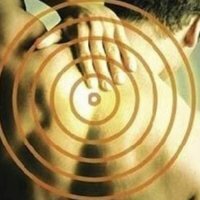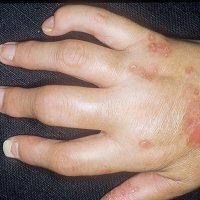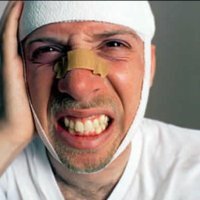Clubfoot in children: symptoms and treatment
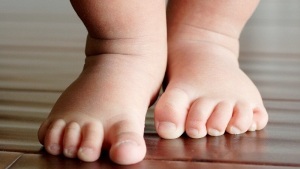
Clubfoot is a common defect in the musculoskeletal system, which consists in the deformation of the foot and the inability to put the foot on the floor.This disease is well studied, there are a number of techniques that help to solve the problem.The main thing is to start treatment in time and follow all the doctor's recommendations.
Table of contents:Species clubfoot
This pathology can be one-sided and two-sided, typical and atypical, congenital and acquired.
Typical clubfoot form in children
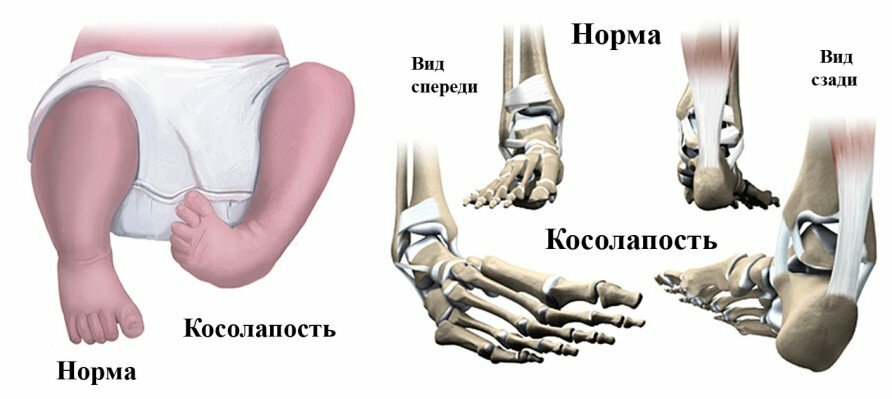
This pathology arises due to a disruption in the development of muscles and tendons. Typically, the typical clubfoot form does not go beyond the foot, but is divided into 3 types:
- 1 degree ( varus contractures) - a feature is the ease of the anomaly flow and the available ability to adjust the child's foot in manual mode;
- 2nd degree ( soft tissue form) - rare enough, characterized by soft tissue resistance when trying to give the foot a normal position;
- 3 degree ( bone form) - also rare, characterized by persistent deformation, restriction of the joint and strong changes in the soft tissues and bones.This clubfoot does not lend itself to conservative treatment.
Atypical clubfoot form in children
This pathology develops against a backdrop of complex disorders of the musculoskeletal system, which include:
- longitudinal ectromelia - absence of bone, considered an inherent defect;
- arthrogryposis is a disease of the musculoskeletal system, which is characterized by multiple joint damage, muscle atrophy and deformity of the limbs;
- Amniotic constrictions are soft "threads" that connect two walls of the uterus to each other.As a rule, these constrictions do not exert any influence on the course of pregnancy and intrauterine development of the fetus, but can provoke congenital clubfoot;
- Dysostosis is a hereditary bone disease that is characterized by the formation of bone tissue in the wrong places( for example, instead of cartilage there is bone);
- underdevelopment of the tibia and other birth defects of the shins;
- Osteochondrodysplasia is a hereditary disease characterized by skeletal defects due to improper ripening of the cartilaginous tissue.In addition to this classification, the disease under consideration can occur in varying degrees of severity:
- light clubfoot - movements in the ankle joint of the child are fully preserved, and correction of the foot position is carried out quickly and without the intervention of surgeons;
- average degree of - the movement of the ankle in the child is severely limited, the disease is treatable, but with great difficulty;
- severe degree - the deformity of the foot in the child is so pronounced that no conservative methods of treatment will help, resort to surgical intervention.
Clubfoot of the newborns, or congenital clubfoot
In general, the clubfeet of the fetus can be detected at 16 weeks of gestation - an experienced Uzi doctor will pay attention to some characteristic signs of the disease. These include:
-
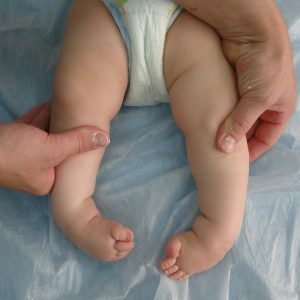 twisting of the shin bones out - torsion;
twisting of the shin bones out - torsion; - the outer edge of the child's foot is lowered, the outer edge is raised, and the foot itself "looks" at the other foot - the equinus;
- full turn of the foot, characterized by the fact that its sole "looks" upwards - adduction( an extremely severe degree of congenital clubfoot);
- deformation of the foot with an emphasis on its outer part - the varus.
For these four signs, a doctor with an ultrasound examination of a pregnant woman can diagnose a congenital clubfoot to the child's future. At the birth of a child, a neonatologist can immediately confirm the diagnosis, especially since there are several other signs for this:
- the toe of the foot is lowered down, and the heel is raised;
- the heel axis is inwardly displaced( relative to the shank axis);
- of the foot in a child is much smaller than it should be at birth;
- ankle joint moves in a restricted manner;
- there is a groove of Adams - a transverse inflection of the sole.
Many people are interested in the cause of the development of congenital clubfoot. Doctors distinguish several such provoking factors:
- heredity - it is necessary to take into account the fact of having a congenital clubfoot in one of the relatives;
- genetic problems - it's about serious diseases( for example, Edwards syndrome), which are characterized by numerous pathologies;
- Mechanical causes of - congenital clubfoot can develop when the uterus is squeezed, putting pressure on the fetus, which occurs against the background of low blood pressure or fetal positioning in the uterus;
- various pathologies in fetal development - maternal avitaminosis, pathological course of pregnancy, primary deficiency of nerve fibers, drug use during pregnancy, disorders in the development of the musculoskeletal apparatus of the fetus.
Acquired clubfoot in children
As a rule, visible disturbances of the foot setting begin to appear in a child aged 2-3 years. At the same time, both parents and a pediatrician when examining the baby can distinguish the following signs of developing clubfoot:
- the ankle does not move well;
- the child incorrectly puts stops - this is especially noticeable on wet sand or snow when the track from one leg is turned towards the other( stably);
- , the thumb of the foot begins to deflect inwards, provoking the appearance of cones on the inner edge of the foot;
- changes the gait of the child - it is called "bearish" in the people, when the kid rakes his feet with sand / earth;
- knees "look" inwards.
Note: is especially well visible for signs of clubfoot acquired in children during sleep, when their muscles are relaxed.
Causes of development of acquired clubfoot in children:
-
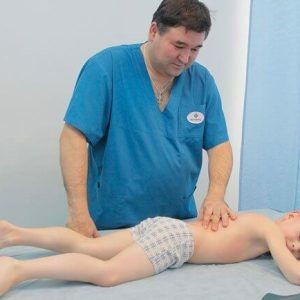 appearance of flaccid and spastic paralysis, which indicates a violation of the nervous system;
appearance of flaccid and spastic paralysis, which indicates a violation of the nervous system; - various leg injuries;
- stop burns;
- inflammatory processes of the acute form of the flow of various etiologies;
- underdevelopment of baby bones( dysplasia);
- rickets;
- is a post-fracture complication in which the bones of the foot or shin are not correctly fused;
- poliomyelitis;
- wearing incorrectly selected shoes.
The clubfoot of the acquired type develops against the background of increasing load on the baby's legs - the bones grow quickly, change their shape, but the muscle tissues and ligaments simply do not keep up with this growth.As a result, some muscles are constantly in a tone, and some are always relaxed, which leads to deformation of the foot.
Therapeutic treatment of clubfoot in children
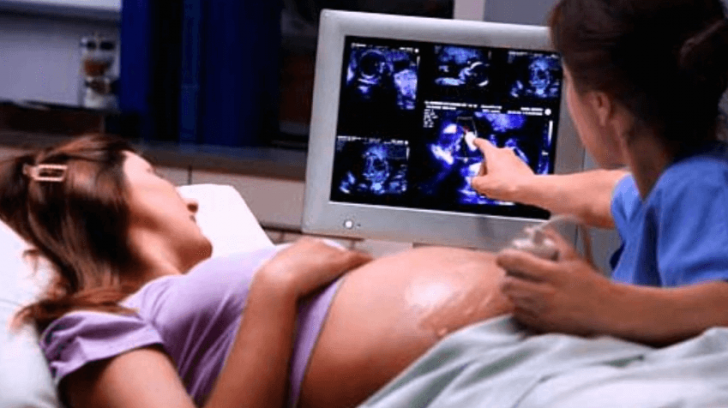
It is quite easy to diagnose the pathology in childhood when it is done by a doctor who is diagnosed with a pregnant woman, either a neonatologist in a maternity hospital or a pediatrician. But whenever a diagnosis is made, one must adhere to the basic principles of successful treatment of anomalies:
- The onset of treatment should be timely and early.
- The child should be constantly observed by an orthopedic physician.
- Parents should be persistent and patient - the treatment will be lengthy.
How to treat congenital clubfoot
This diagnosis is put to the child in the hospital, so doctors start treatment early - the chances of a full recovery are very high.As a rule, to therapeutic treatment with congenital clubfoot can be started 7 days after the birth of the child.Usually, treatment is performed on an outpatient basis under the supervision of a physician-therapist, it is extremely rare to hospitalize a child to treat the anomaly in question.

What is the principle of treating congenital clubfoot in a baby:
- The baby's foot is fixed with a cast strip that changes every week.
- After the final removal of gypsum and straightening of the foot, the child needs to wear a specially selected linget at night - this will fix the result and prevent the development of relapses.
In general, such treatment of congenital clubfoot is considered the most effective, especially since the child's bones are still soft and easily amenable to correction.But many doctors prefer the method of Vilnius , which helps to solve the problem of clubfoot not only in newborns, but also in older children.Often the method Vilensky makes inappropriate to conduct surgery, and the effect you want can be achieved 2-3 times faster than with the classical gipsovanie legs of the child.
Treatment of congenital clubfoot by the method of Vilensky refers to complex methods and covers the following areas:
- "boots" - phased gypsum;
- complete immobilization of joints with special devices( tutors);
- paraffin applications;
- exercise therapy, which consists in the appointment of a special load;
- medical gymnastics - the complex is selected by the attending physician-orthopedist;
- massage with clubfoot, appointed by a neuropathologist;
- regularly held warm baths with pine extract.
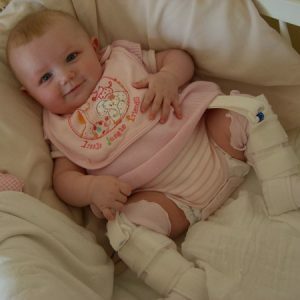 The most common treatment for congenital clubfoot is by staged plastering.Orthopedic surgeon first carefully massages the baby's foot( without force receptions), and when the leg begins to yield to the hands of a specialist, it is impregnated with gypsum.In this position, the leg should be a week, then the plaster is removed and the doctor starts kneading the foot further, putting some effort and achieving another change in its position.Typically, such treatment is carried out throughout the year, along with paraffin applications.After the main course of treatment, children are recommended to wear orthopedic shoes to fix the result.
The most common treatment for congenital clubfoot is by staged plastering.Orthopedic surgeon first carefully massages the baby's foot( without force receptions), and when the leg begins to yield to the hands of a specialist, it is impregnated with gypsum.In this position, the leg should be a week, then the plaster is removed and the doctor starts kneading the foot further, putting some effort and achieving another change in its position.Typically, such treatment is carried out throughout the year, along with paraffin applications.After the main course of treatment, children are recommended to wear orthopedic shoes to fix the result.
In addition to gypsum, there are many ways to treat congenital clubfoot, one of them is the introduction of Botox.This means affects the nerves, so when Botox is introduced into the gastrocnemius muscle, the gastrocnemius relaxes - the foot assumes the correct position.The effect of this injection lasts a maximum of 6 months, but then treatment can be repeated.Yes, the effect of Botox injections is not as long as after surgical treatment, but this correction of the foot can solve the problem of clubfoot, which proceeds in an average degree of severity, without painful procedures and scars.
Note: method of treatment of congenital clubfoot is always chosen by an orthopedic doctor, taking into account the severity of the course of the anomaly, the overall health of the baby, the age of the child, the individual characteristics of the organism.
How to treat acquired clubfoot in children
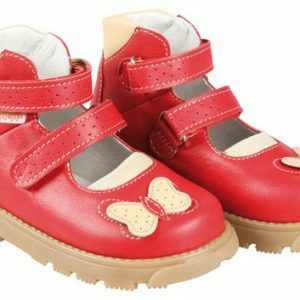 First of all, the doctor should find out the cause of development of acquired clubfoot in a child and only after that can an effective treatment be selected.But, as a rule, the essence of therapy is reduced to fixing the joint, conducting a course of massage and specially selected physical exercises.Children in older age should wear orthopedic footwear with a firm back and a shoe that fixes the ankle.
First of all, the doctor should find out the cause of development of acquired clubfoot in a child and only after that can an effective treatment be selected.But, as a rule, the essence of therapy is reduced to fixing the joint, conducting a course of massage and specially selected physical exercises.Children in older age should wear orthopedic footwear with a firm back and a shoe that fixes the ankle.
Usually, the treatment of acquired clubfoot is 3-4 months, in a year it is necessary to pass 2-3 such courses, so that the problem of acquired clubfoot was solved.Doctors recommend that older children actively engage in sports - swimming, dancing and other kinds.
If conservative methods of treatment of the disease in question do not give the desired result, then doctors can prescribe surgical treatment of clubfoot.
Surgical treatment of clubfoot
Doctors recommend starting surgical treatment of clubfoot in children aged 8-9 months - it should be completed by the time the baby goes.For this type of treatment, doctors can use several different techniques.
Ponsetti method
Treatment by this method can be started at the age of 1-2 weeks.First, a step-by-step plastering of the baby's leg from the fingers to the upper third of the thigh is prescribed.The main difference between gypsum on this method is that the position of the foot is corrected immediately in several planes, so the usual orthopedist, without special preparation, can not perform this manipulation.
The plaster cast varies 6-7 times until several degrees remain until the defect is completely corrected.At this point, the doctor must perform the operation( on an outpatient basis), which is a small incision of the Achilles tendon, which gives the stop more freedom "for a turn."
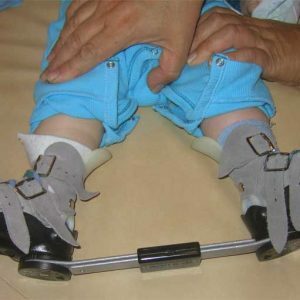 After the child's leg is correctly positioned and the wound heals after surgery, the doctor orders wearing special shoes - braces , which are classified as complex orthopedic shoes.At the beginning of this stage the child should wear a brace 23 hours a day, then this period gradually decreases, and by the age of 2 the baby can be worn only at night.
After the child's leg is correctly positioned and the wound heals after surgery, the doctor orders wearing special shoes - braces , which are classified as complex orthopedic shoes.At the beginning of this stage the child should wear a brace 23 hours a day, then this period gradually decreases, and by the age of 2 the baby can be worn only at night.
Recurrences of clubfoot after treatment with the Ponsetti method are extremely rare, but in this case the specialists again conduct all the steps and achieve the desired result.
Corrective osteotomy
This type of surgical treatment of the anomaly in question implies the use of the Ilizarov apparatus - it is intended for long-term fixation of the bone.With the help of the device, doctors can stretch or compress bone tissue, which allows to solve the problem of clubfoot, even with diseases and deformities of bones.
In general, there are a lot of operations to correct clubfoot.For example, if there is paralytic clubfoot, then the doctors repair the damaged nerve, or they transplant the tendon to the patient.In some cases, arthrodesis is performed - an operation that involves tight fixation of the joint and an increase in the supporting capacity.
After the surgical treatment the child must wear special orthopedic footwear for another year.But even after such a difficult and long treatment, the muscles of the foot will be stiff, the legs will constantly ache, and the size of the foot of the diseased leg will be 1-1.5 times smaller than the healthy one.
Preventative measures
Any disease is better prevented than treated - this applies to clubfoot.There are clear rules for the prevention of the anomaly in question.During pregnancy, for example, a woman should lead a healthy lifestyle, get adequate nutrition, observe the regime of the day. And after the birth of the child, doctors recommend that the following rules be observed:
-
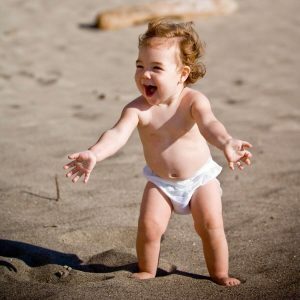 Always look closely at the baby's tracks on wet sand or snow - the feet should stand parallel to each other, and the socks - slightly apart.
Always look closely at the baby's tracks on wet sand or snow - the feet should stand parallel to each other, and the socks - slightly apart. - Pay attention to the gait of the child, especially if the tracks are alert.Note changes in the gait can be in the morning or during the game, when the child is distracted or sleepy and does not control his gait.The reason for applying to the orthopedist should be "zagrebuie" movement of the legs.
- The child should exercise regularly - cycling, squatting, snowboarding or skateboarding.
- If the baby has just started walking, then long walks are contraindicated for him - take a stroller or a bicycle.
- If the baby has excess weight, then you need to urgently go to the pediatrician and a dietician to restore the normal physical form of the child.
- Swimming is considered the best prevention of diseases of the musculoskeletal system, including clubfoot.
- The nutrition of the child should be varied and must include milk, fish, cottage cheese and all sour-milk products - they contain calcium, which is necessary for the formation of a healthy musculoskeletal system.
- It is useful for children to walk barefoot on grass, pebbles and sand.
- Wearing children only need quality shoes with a hard back and a good instep.
- It will also be useful to walk up and down the stairs.
Parents should understand that even an easy clubfoot can lead to severe consequences.Therefore, when the first signs of deformity of the foot appear, you need to seek professional medical help from an orthopedist - this will help to quickly solve the problem and avoid complications.
Tsygankova Yana Aleksandrovna, medical reviewer, therapist of the highest qualification category

